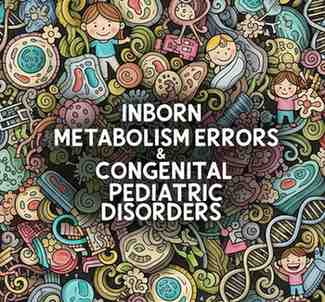
Your Account
Designed by Zeptt Technologies

INBORN ERRORS OF METABOLISM (IEM)
Inborn Errors of Metabolism are a group of rare genetic (hereditary) disorders in which the body cannot properly turn food into energy due to enzyme defects.
ETIOLOGY
Congenital enzyme deficiencies
Autosomal recessive or X-linked inherited disorders
Defective metabolic pathways of amino acids, carbohydrates, fatty acids, or urea cycle
AYURVEDIC CORRELATION
Beeja dosha (genetic mutation)
Garbhaja vikriti (congenital deformity due to doshic imbalance in fetal stage)
"Beeja bhaga avayava vikriti garbhasya vikritim janayati" – Charaka Samhita Sharira Sthana
TYPES (BASED ON METABOLIC DEFECT)
Carbohydrate metabolism disorders: Galactosemia, Glycogen storage diseases
Amino acid metabolism disorders: Phenylketonuria (PKU), Maple syrup urine disease
Fatty acid oxidation disorders
Urea cycle disorders
Mitochondrial disorders
CLINICAL FEATURES
Lethargy, vomiting, failure to thrive
Seizures, developmental delay
Unusual odor of urine or body
Hepatomegaly, acidosis, hypoglycemia
DIAGNOSIS
Tandem mass spectrometry (TMS)
Gas chromatography-mass spectrometry (GC-MS)
Serum ammonia, lactate, blood gas analysis
Urine organic acid analysis
MANAGEMENT
Early detection through newborn screening
Dietary restriction of offending nutrient
Enzyme replacement therapy
Supportive care
CONGENITAL RUBELLA SYNDROME (CRS)
INTRODUCTION
CRS is caused when rubella virus infects the fetus through placental transmission, especially during the first trimester.
AYURVEDIC VIEW
Garbha janya vyadhi due to krimi/jeevanu
Influence of Dushta Rakta or Beeja dushti
SANSKRIT REFERENCE
"Garbhasya abhinirvrutti doshaat vikritir bhavet" – Kashyapa Samhita
CLINICAL FEATURES
Sensorineural deafness
Cataracts, congenital glaucoma
Congenital heart defects (PDA, pulmonary artery stenosis)
Microcephaly, mental retardation
"Blueberry muffin" rash (dermal erythropoiesis)
DIAGNOSIS
Maternal rubella IgM/IgG titres
Infant IgM antibodies to rubella
PCR for rubella RNA
PREVENTION
Rubella vaccination (MMR) prior to pregnancy
CELIAC DISEASE
INTRODUCTION
An autoimmune condition triggered by ingestion of gluten in genetically predisposed individuals leading to intestinal mucosal damage.
AYURVEDIC CORRELATION
Grahani Dosha
"Grahani tu agnimandyaat dosha chapi samirita" – Ashtanga Hridaya
CLINICAL FEATURES
Chronic diarrhea, steatorrhea
Abdominal bloating, failure to thrive
Iron deficiency anemia
Short stature, irritability
DIAGNOSIS
Anti-tTG (IgA) antibodies
Duodenal biopsy showing villous atrophy
HLA-DQ2/DQ8 genetic typing
TREATMENT
Lifelong gluten-free diet
Nutritional supplementation
SPINAL MUSCULAR ATROPHY (SMA)
INTRODUCTION
Genetic neuromuscular disorder causing degeneration of anterior horn cells in spinal cord leading to muscle wasting.
ETIOLOGY
Autosomal recessive mutation in SMN1 gene
AYURVEDIC VIEW
Mamsa kshaya, Vata vyadhi
"Mamsa heenatvam dehasya shithilam cha pravartate" – Charaka Samhita
CLINICAL FEATURES
Progressive muscle weakness
Hypotonia (floppy baby)
Absent deep tendon reflexes
Feeding and breathing difficulties
DIAGNOSIS
Genetic testing for SMN1 deletion
EMG and nerve conduction studies
TREATMENT
Nusinersen (antisense oligonucleotide therapy)
Gene therapy (Zolgensma)
Supportive care: physiotherapy, respiratory support
GUILLAIN-BARRÉ SYNDROME (GBS)
INTRODUCTION
An acute inflammatory demyelinating polyradiculoneuropathy often post-infectious, leading to ascending paralysis.
ETIOLOGY
Autoimmune response following infections (Campylobacter jejuni, CMV)
AYURVEDIC CORRELATION
Avarana vata or Sarvanga vata
"Vata atipravatam yatra kampam cha janayatyasau" – Charaka Samhita
CLINICAL FEATURES
Rapid onset symmetrical weakness
Areflexia
Respiratory muscle involvement
Cranial nerve palsies
DIAGNOSIS
CSF: albuminocytologic dissociation
Nerve conduction studies
MRI spine
TREATMENT
IVIG or plasmapheresis
Supportive ventilation if needed
SICKLE CELL ANEMIA
INTRODUCTION
Hereditary hemoglobinopathy due to mutation in beta-globin gene, leading to sickle-shaped RBCs.
AYURVEDIC VIEW
Raktapradoshaja vyadhi, Pandu
"Rakte doshat tridoshaja panduta jayate" – Charaka Samhita
CLINICAL FEATURES
Anemia, jaundice
Painful vaso-occlusive crises
Splenomegaly, dactylitis
Stroke, infections
DIAGNOSIS
Hemoglobin electrophoresis
Peripheral smear
Sickle solubility test
MANAGEMENT
Hydroxyurea
Folic acid supplements
Pain control
Bone marrow transplant (curative)
WILSON’S DISEASE
INTRODUCTION
Autosomal recessive disorder of copper metabolism due to ATP7B gene mutation leading to copper accumulation in liver, brain, and eyes.
AYURVEDIC CORRELATION
Yakrit vikara, Meda dushti, Manovikara
"Meda mamsa rakta pitta yakrit pittashaya dushayati" – Ashtanga Hridaya
CLINICAL FEATURES
Hepatic: hepatitis, cirrhosis
Neurological: tremors, dysarthria
Psychiatric: depression, personality changes
Kayser-Fleischer rings in eyes
DIAGNOSIS
Serum ceruloplasmin low
24hr urinary copper high
Liver biopsy (copper quantification)
TREATMENT
Chelating agents (D-penicillamine, Trientine)
Zinc supplementation
Liver transplant in severe cases
UTPULLIKA
AYURVEDIC DESCRIPTION
A type of Balagraha involving sudden distension or protrusion of body parts, often associated with dosha vitiation.
SANSKRIT REFERENCE
"Utpullika balasya shirasi sphotaka iva bhavet" – Kashyapa Samhita, Khilasthana
PRESENTATION
Rapid swelling in head region
Associated fever or delirium
Possible correlation: pediatric abscess or cyst
MANAGEMENT
Snehan, Swedan, Lekhana karma
Internal medications: Haridra, Shunthi, Guggulu-based formulations
AJAGALLIKA
AYURVEDIC DESCRIPTION
A type of Gala ganda in children presenting as hard swelling in the throat or neck region
SANSKRIT REFERENCE
"Gala gande ajagallika granthi yukta drudhapidita" – Kashyapa Samhita
CLINICAL CORRELATION
Could be related to enlarged lymph nodes, thyroglossal cyst or congenital goitre
TREATMENT
Shothahara and Granthi hara chikitsa
Guggulu, Kanchanara, Trikatu formulations
KUKUNAKA
AYURVEDIC DESCRIPTION
Condition in infants where the uvula (taluka) is swollen, elongated or deviated causing difficulty in suckling
SANSKRIT REFERENCE
"Talukasya unnati kukunaka lakshanam" – Kashyapa Samhita
MODERN CORRELATION
Elongated uvula, uvulitis
SYMPTOMS
Difficulty in breastfeeding
Gagging or regurgitation
TREATMENT
Local lekhana, pratisarana
Use of honey with Haridra and Yashtimadhu
TALU KANTAKA
AYURVEDIC DESCRIPTION
Refers to foreign body sensation or actual obstruction in the palate (talu) or throat (kantha)
SANSKRIT REFERENCE
"Talu kantaka yadi kanthe kashtam janayati prashwashe" – Kashyapa Samhita
POSSIBLE MODERN CORRELATION
Congenital oral cavity anomalies, cleft palate remnants, foreign body
MANAGEMENT
Gentle removal if mechanical obstruction
Local soothing herbs like Yashtimadhu, Shunthi